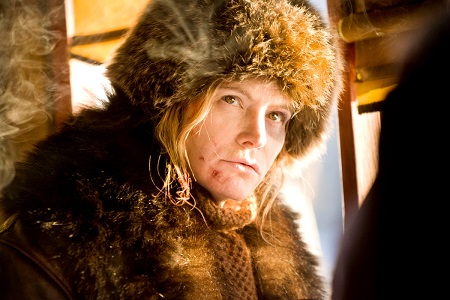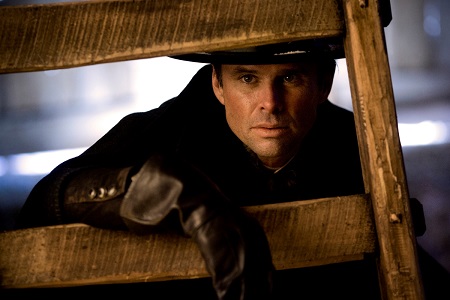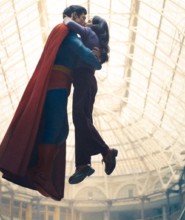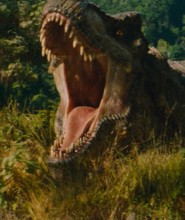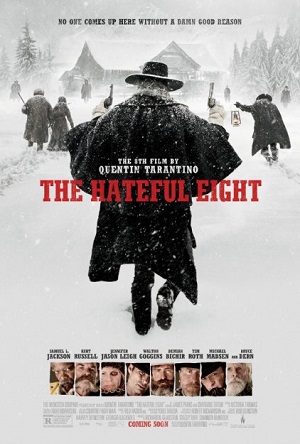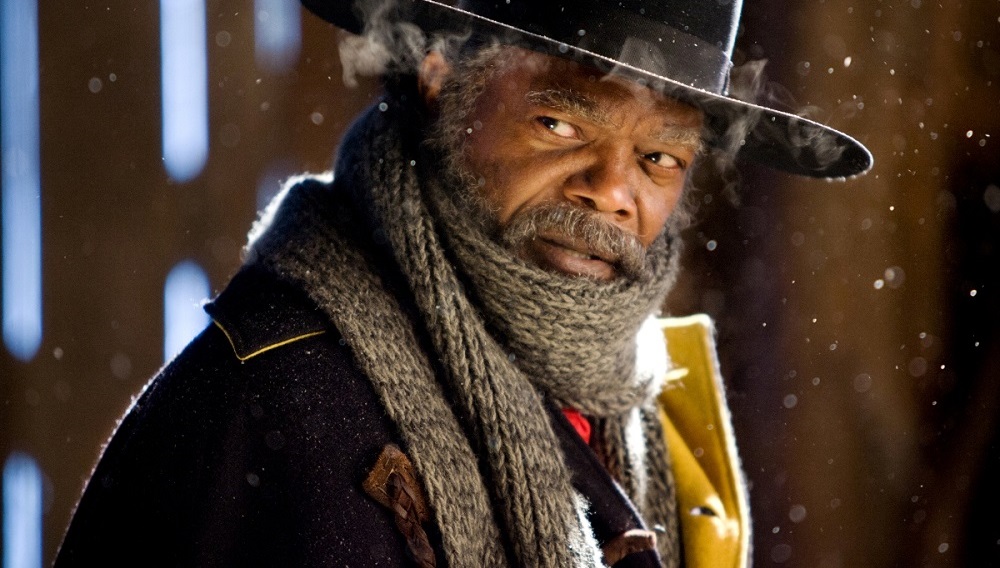
Tarantino’s Eight a Love/Hate Enigma
John “The Hangman” Ruth (Kurt Russell) is taking the stagecoach to Red Rock, fugitive Daisy Domergue (Jennifer Jason Leigh) shackled next to him, the fearsome bounty hunter shepherding the murderess to town for a date with a rope swinging plaintively from a gallows. On the mountain road to Minnie’s Haberdashery, with a hellish blizzard bearing down on them, the coach encounters a pair of stranded travelers. One is former Union war hero turned bounty hunter Major Marquis Warren (Samuel L. Jackson), the other a one-time Southern renegade, Chris Mannix (Walton Goggins), claiming to be the new Sheriff of Red Rock.
The distrustful quartet make it to Minnie’s only to discover their not the only ones looking for sanctuary from the storm at the mountainside stagecoach stopover, four men warmly ensconced within to wait out the coming blizzard. There’s Bob (Demian Bichir), a Mexican claiming to be looking after the place while Minnie (Dana Gourrier) and her partner Sweet Dave (Gene Jones) are away. Joining him are fellow travelers Oswaldo Mobray (Tim Roth), the county hangman heading to Red Rock to facilitate Daisy’s demise, cowpoke Joe Gage (Michael Madsen), going home to spend Christmas with his mother, and former Confederate General Sandy Smithers (Bruce Dern), a man Major Warren is only far too familiar with.
It will shock no one to learn that little is as it seems in Quentin Tarantino’s latest genre free-for-all The Hateful Eight. One part intimate old school Western recalling William Wyler’s The Big Country, another reveling in the Italian Spaghetti theatrics directors like Sergio Leone (The Good, the Bad and the Ugly) and Sergio Corbucci (The Big Silence) practically invented, the movie’s most obvious comparison might actually be the works of playwright Tennessee Williams, the scenario at hand owing more to Cat on a Hot Tin Roof than it does Once Upon a Time in the West or Shane.
You could probably add Agatha Christie to the mix, as the film has a Ten Little Indians quality that’s understandably unavoidable. Even so, even with Robert Richardson’s (Hugo) lush, marvelously refined Ultra Panavision 70 widescreen cinematography, even with picturesque images of a wintry Wyoming countryside (actually Telluride, Colorado, but who’s complaining) under direct assault from Mother Nature, this story is all about how the characters interact coupled with Tarantino’s signature sing-song foul-mouthed dialogue. It’s a character study, one involving a group of disparate travelers all under unfathomable duress, who they are what their collective intentions might be only ascertained step by bloody, cranium-shattered step.
This is Tarantino’s most overtly political film. Debates about race, gender, politics and economic disparity are littered throughout, none exactly coy about what it is that is being said nor how these conversations taking place in a post-Civil War U.S. relate to the discussions happening out in the zeitgeist today. Most of this, not surprisingly, directly involves Major Warren, his interactions with General Smithers, Chris Mannix and even Daisy Domergue walking a potentially inflammatory line with fearless aplomb. Jackson makes the most of these sequences, delighting in every turn of phrase, making the violence, usually coming from out of nowhere, pack a far meaner punch than it ever could have without his tremendous efforts.
Yet in a movie overflowing in glorious elements, there is a distasteful aura I found impossible to get beyond. While I’m sure Tarantino is aiming to make some rather profound statements in regards to gender norms and racial disparities in the modern world, and even though Leigh throws her into things with wild-eyed ferocious glee, the misogynistic temperament permeating things drove me crazy. Daisy gets slapped around, punched, strangled, has teeth knocked out and is called all sorts of names, the majority rhyming with “witch” and “chore.” None of which would be too awful had her backstory even been slightly more fleshed out or realized, or if she could have exacted some sort of physical retribution against those manhandling her. Instead, she’s really nothing more than a device, a way for the remainder of the characters to work out their personal issues or come senselessly flying to her defense.
There’s something repugnant about this, a thing that annoys and disturbs me in ways I cannot for whatever reason put a name to or describe as fully as I would like to. Be that as it may, Daisy feels like someone who is only around for others to treat as a punching bag or a punchline, and by the time she had another poor soul’s brains splattered all over her purple-bruised face I felt like Tarantino had forgotten about all those great female characters he’d created for Jackie Brown, Kill Bill, Inglourious Basterds and Death Proof. Instead, it was like he had become so obsessed with making a statement he somehow forgot along the way to make a reasoned, let alone well thought-out, one, Leigh left holding a rather abhorrent bag as she valiantly attempted to make the most of a fairly disgusting situation.
Even so, there’s so much going on inside The Hateful Eight I find I cannot stop thinking about it. Legendary composer Ennio Morricone (A Fistful of Dollars, The Untouchables) provides a stupendous, unnervingly magnificent score that fits the tone and mood perfectly, while Fred Raskin’s (Guardians of the Galaxy) editing is some of the finest I’ve seen in all of 2015. The film is also a triumph of production design and art direction, Yohei Taneda’s (The Flowers of War) handling of the former and Richard L. Johnson’s (State of Play) crafting of a latter helping to give things a lived-in look and feel that’s marvelous.
Then there is Goggins. The former “Justified” scene-stealer is unbelievably great as Mannix. By all accounts playing the scenario’s most challenging character, he’s asked to go from being a cartoonish, absurdly racist buffoon, to mixed-up bumpkin in way out of his league, to level-headed lawman ready to do whatever it takes to see justice accomplished. Goggins went from provoking y my disgust to achieving my sympathies, his complex emotional evolution revealing an innate humanity that’s something close to incredible.
But what’s the point? That’s what I keep scratching my head over. Tarantino is riffing in one of his favorite genres, and it’s clear he’s having a great time. But it’s also just as obvious he’s got plenty on his mind and tons he wants to say. Problem is, little of it is clear. Worse, most of it gets drowned in so much guts and gore, not to mention irredeemably abuse and sexism, listening to it is close to impossible. The Hateful Eight has lots to love, but just as much to abhor, making it an elegant enigma that’s as frustrating as it is impressive.
Review reprinted courtesy of the SGN in Seattle
Film Rating: 2 (out of 4)


